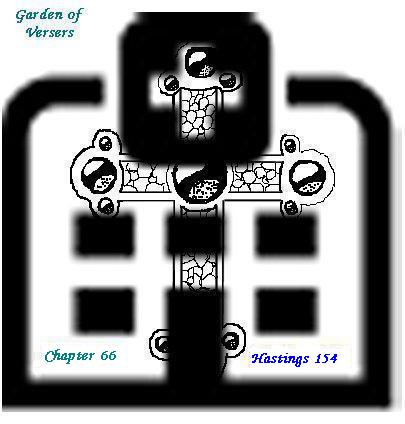
Patreon or PayPal Me keeps this site and its author alive. Thank you. |
Stories from the Verse
Garden of Versers
Chapter 66: Hastings 154
Table of Contents
Previous chapter: Chapter 65: Kondor 147

“What color was the house?”
The doctor had barely sat down before he asked this question, and Lauren was not at all certain what he was asking. “I’m sorry,” she said, “what?”
“The house. What color was it?”
Lauren shook her head as if trying to clear it. “I’m sorry,” she said. “Which house?”
“Oh, I’m sorry,” the doctor replied. “I meant the house in Somerdale where you grew up.”
“Oh! It was a kind of a slate blue-gray.”
“And Maria’s house next door?”
“I think it was green; a good part of the front was brickface, but the side that faced our yard was definitely green.”
“And the house across the street from her, where those two boys lived?”
“Brickface below and white above. I think Ricky’s house was, too, but there were a lot of trees in his yard and you couldn’t see much of the house from the street. The house directly across the street from us was yellow. Mister and Missus Brown lived there; they were older and had no children, so I didn’t have much contact with them except when my mother sent me across the street on an errand.”
“When the boys moved out from across the street, who moved in?”
“Their name was Mahoney, and when I was a little older I babysat for their two kids, Jimmy and, let me think, right, Shelly. Their names were actually James and Michelle, but no one called them that that I ever heard.”
It occurred to Lauren that Doctor Conway was plying her for details to test the reality of what he was still assuming was her delusions. Of course, it was a much longer time ago than he would believe, but it really happened and she could remember quite a bit of it.
“What color was your room?”
“The nursery was yellow. When my brother was born, my sister and I moved to the end of the hall, and that room was pink. The living room, dining room, and front hall were all kind of beige, but the kitchen was green, with pine cabinets and multicolored linoleum counters. It had a double sink and a dishwasher. What color was your mother’s kitchen?”
The doctor smiled. “All right,” he said. “You know details. Let’s continue with the start of school. You said that you and Maria were not in the same kindergarten class.”
“Yes, I remember coming home from my first day of school and going next door to see if she could come play, only to discover that she was just heading out the door for her first day of school.”
“So what do you remember about school?”
“You’re definitely taxing my memory. I don’t remember all of my teachers. Some of the kids who were in my kindergarten graduated high school with me, but I couldn’t be sure which of my high school friends were actually in my kindergarten class and who I met later.”
Lauren actually remembered six of the seven teachers she had through the sixth grade; her third grade teacher’s name and face eluded her. She remembered dozens of classmates, a couple of music teachers, and the principal. She also remembered a few projects and events, such as the Mexican dinner they had put together when studying Central America, the hand puppet she made in one class, and the book about African animals she had put together as a report one year.
Her mention of Mexico and Central America derailed the discussion. She hadn’t realized how different this world was from her own. Doctor Conway wasn’t telling her much, but it seemed that sometime around the time Columbus discovered the new continents, things took a very different course, and although when she described the continents Doctor Conway recognized them, none of the names this side of the Atlantic were the same. To him it seemed that she could remember much of Europe, Africa, Asia, and the Middle East, but had entirely reinvented what she called America. They also apparently had a different name for Australia, but he would not tell her what he considered the “real” names of these places, as he said he wanted to know just how deep her delusions went and whether she would recall the real names on her own.
The geography of the new world remained the focus as the session began the next day, Doctor Conway seemingly stupefied at the detail of what he still took to be her imaginary experience in another world. She tried to explain Canada, the United States of America, Mexico, and quite a few Central and South American countries such as Venezuela, Columbia, Peru, Brazil, Argentina, Ecuador, and Panama. She was able to name about forty states before she started duplicating them and lost count (she thought perhaps she could have written them down, but she still wasn’t being trusted with anything as dangerous as a writing implement). She recalled the names of five Canadian provinces and several Caribbean islands, although she was not certain of their relative positions.
Her knowledge of Europe proved to be significantly lacking. Although this was the mid nineteen-sixties, the twentieth century had been very different, and the map of Europe had been redrawn under different influences. There was still an Austrian Empire; Czarist Russia had transformed into a democratic constitutional monarchy very similar to Great Britain. There had been no world wars, no Holocaust, no nuclear bombs. At least, these were what she gleaned from the doctor’s reactions to her descriptions. She shrugged it off. “I told you I’m not from this world,” she said. “It’s not surprising that I don’t know all about it; it’s more surprising that your world is as similar to mine as it is. But it’s not inexplicable.”
“No?” he challenged. “How would you explain it?”
Lauren shifted. “There’s a theory of the multiverse that says that whenever any one thing happens when a different thing could have happened,” she said, “both things happen, and that universe splits into two universes. I don’t believe that; it’s too much. However, I can see that at least sometimes universes might split, that the history of two worlds might be perfectly identical until a moment when one difference arises, and thereafter they diverge into completely different worlds with the same history. Our worlds seem to have been the same up until Columbus discovered what in my world was eventually called America, after Amerigo Vespucci. Whether they split apart at that point or were always two worlds indistinguishable from each other is a guess, but given certain deterministic assumptions it is entirely plausible that two worlds would have the same history for eons.”
The doctor nodded as if this made some sense, but not as if he believed it.
“So,” he said, “next time we’ll pick up with the end of elementary school and move forward."
There is a behind-the-writings look at the thoughts, influences, and ideas of this chapter, along with twelve other sequential chapters of this novel, in mark Joseph "young" web log entry #293: Versers Relate. Given a moment, this link should take you directly to the section relevant to this chapter. It may contain spoilers of upcoming chapters.
As to the old stories that have long been here:

